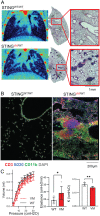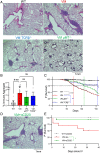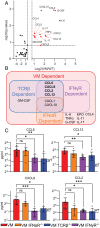Radioresistant cells initiate lymphocyte-dependent lung inflammation and IFNγ-dependent mortality in STING gain-of-function mice
- PMID: 35696583
- PMCID: PMC9231608
- DOI: 10.1073/pnas.2202327119
Radioresistant cells initiate lymphocyte-dependent lung inflammation and IFNγ-dependent mortality in STING gain-of-function mice
Abstract
Pediatric patients with constitutively active mutations in the cytosolic double-stranded-DNA-sensing adaptor STING develop an autoinflammatory syndrome known as STING-associated vasculopathy with onset in infancy (SAVI). SAVI patients have elevated interferon-stimulated gene expression and suffer from interstitial lung disease (ILD) with lymphocyte predominate bronchus-associated lymphoid tissue (BALT). Mice harboring SAVI mutations (STING V154M [VM]) that recapitulate human disease also develop lymphocyte-rich BALT. Ablation of either T or B lymphocytes prolongs the survival of SAVI mice, but lung immune aggregates persist, indicating that T cells and B cells can independently be recruited as BALT. VM T cells produced IFNγ, and IFNγR deficiency prolonged the survival of SAVI mice; however, T-cell-dependent recruitment of infiltrating myeloid cells to the lung was IFNγ independent. Lethally irradiated VM recipients fully reconstituted with wild type bone-marrow-derived cells still developed ILD, pointing to a critical role for VM-expressing radioresistant parenchymal and/or stromal cells in the recruitment and activation of pathogenic lymphocytes. We identified lung endothelial cells as radioresistant cells that express STING. Transcriptional analysis of VM endothelial cells revealed up-regulation of chemokines, proinflammatory cytokines, and genes associated with antigen presentation. Together, our data show that VM-expressing radioresistant cells play a key role in the initiation of lung disease in VM mice and provide insights for the treatment of SAVI patients, with implications for ILD associated with other connective tissue disorders.
Keywords: SAVI; STING; endothelial cells; interferon gamma; interstitial lung disease.
Conflict of interest statement
Competing interest statement: The authors declare a competing interest. K.A.F. serves as a scientific advisory board member to Janssen, Moderna, Related Sciences, Generation Bio, and NodThera Inc as well as a consultant for Casma Therapeutics, Jnana Therapeutics, Elicio Therapeutics, and OMass Therapeutics.
Figures







Similar articles
-
Endothelial cell expression of a STING gain-of-function mutation initiates pulmonary lymphocytic infiltration.Cell Rep. 2024 Apr 23;43(4):114114. doi: 10.1016/j.celrep.2024.114114. Epub 2024 Apr 15. Cell Rep. 2024. PMID: 38625791 Free PMC article.
-
Activation of autoreactive lymphocytes in the lung by radioresistant cells expressing a STING gain-of-function mutation.JCI Insight. 2024 Jul 18;9(16):e174331. doi: 10.1172/jci.insight.174331. JCI Insight. 2024. PMID: 39024563 Free PMC article.
-
Activation of Autoreactive Lymphocytes in the Lung by STING Gain-of-function Mutation Radioresistant Cells.bioRxiv [Preprint]. 2023 Jul 28:2023.07.28.551002. doi: 10.1101/2023.07.28.551002. bioRxiv. 2023. Update in: JCI Insight. 2024 Jul 18;9(16):e174331. doi: 10.1172/jci.insight.174331. PMID: 37546720 Free PMC article. Updated. Preprint.
-
Lung Inflammation in STING-Associated Vasculopathy with Onset in Infancy (SAVI).Cells. 2022 Jan 18;11(3):318. doi: 10.3390/cells11030318. Cells. 2022. PMID: 35159128 Free PMC article. Review.
-
STING-Mediated Lung Inflammation and Beyond.J Clin Immunol. 2021 Apr;41(3):501-514. doi: 10.1007/s10875-021-00974-z. Epub 2021 Feb 2. J Clin Immunol. 2021. PMID: 33532887 Review.
Cited by
-
PARP7 inhibits type I interferon signaling to prevent autoimmunity and lung disease.J Exp Med. 2025 May 5;222(5):e20241184. doi: 10.1084/jem.20241184. Epub 2025 Feb 19. J Exp Med. 2025. PMID: 39969510 Free PMC article.
-
Endothelial cell expression of a STING gain-of-function mutation initiates pulmonary lymphocytic infiltration.Cell Rep. 2024 Apr 23;43(4):114114. doi: 10.1016/j.celrep.2024.114114. Epub 2024 Apr 15. Cell Rep. 2024. PMID: 38625791 Free PMC article.
-
The common Sting1 HAQ, AQ alleles rescue CD4 T cellpenia, restore T-regs, and prevent SAVI (N153S) inflammatory disease in mice.Elife. 2024 Sep 18;13:RP96790. doi: 10.7554/eLife.96790. Elife. 2024. PMID: 39291958 Free PMC article.
-
ERADication of STING limits inflammation.Nat Cell Biol. 2023 May;25(5):635-636. doi: 10.1038/s41556-023-01142-8. Nat Cell Biol. 2023. PMID: 37142792 No abstract available.
-
Regulation of cGAS and STING signaling during inflammation and infection.J Biol Chem. 2023 Jul;299(7):104866. doi: 10.1016/j.jbc.2023.104866. Epub 2023 May 27. J Biol Chem. 2023. PMID: 37247757 Free PMC article. Review.
References
Publication types
MeSH terms
Substances
Grants and funding
LinkOut - more resources
Full Text Sources
Other Literature Sources
Medical
Molecular Biology Databases
Research Materials

